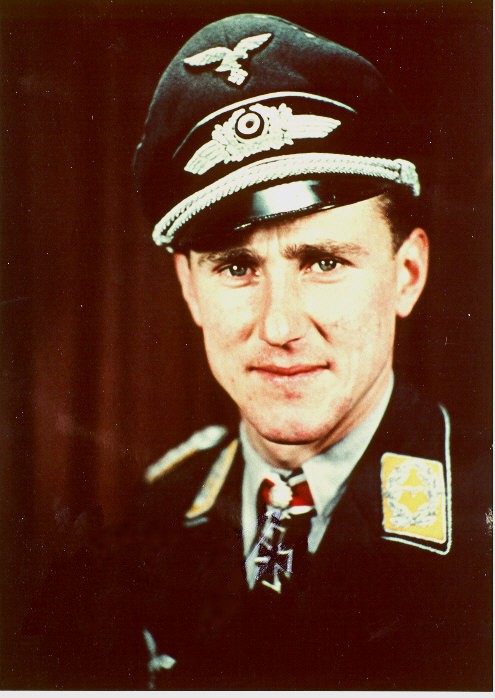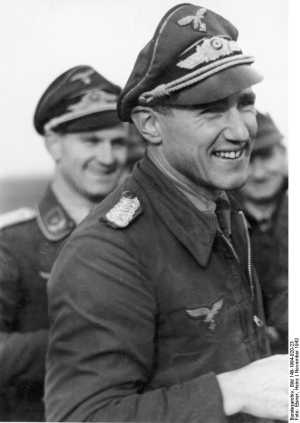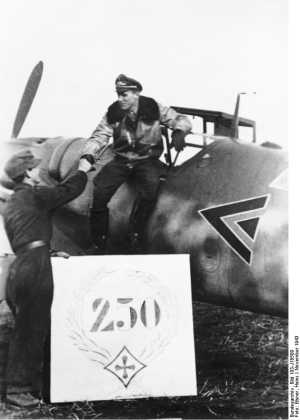Günther Rall
Third-highest scoring ace of all time
By Stephen Sherman, Dec. 2008. Updated July 8, 2011.
After beginning his military career with the army, Günther Rall joined the Luftwaffe in 1938, and posted to Jagdgeschwader 52 (JG.52) just before World War Two. In the early part of the war, he flew in the Battle of France and the Battle of Britain.
His first kill was a Curtiss Hawk 75 over France. During the Battle of Britain, he flew escort for the bombers, and observed first-hand the superior handling and turning qualities of the Spitfire.
In June, 1941, with the start of Operation Barbarossa, JG.52 moved to Costanza, Romania, on the Black Sea coast, where some refineries were expected to draw Russian aerial attacks. When the DB-3 bombers came, Rall and the other Bf-109 pilots flew to intercept. Such was the shortage of spare parts, that only half of the twelve planes in Rall's staffel could take off.
At that time, they were flying the Bf 109F, armed with two cowling-mounted 7.9mm machine guns and a 20mm cannon firing through the hollow propeller shaft. Unusually, this was a reduction in armament from the Bf 109E, which had also been equipped with a pair of guns in the wings; several pilots had reported that concentrated center-mounted firepower was more effective, and that the guns in the wings threw off the airplane's handling.
They intercepted the unescorted Soviet bombers at 15,000 feet. Rall described this early encounter in Edward Sims' book, The Aces Talk:
The Russians were about twenty miles away when we took off and, climbing fast, it wasn't long before we saw them straight ahead. They had come from the Crimea, I think, and the two patrol 109s had already attacked and shot down some of them. When they saw us coming out to meet them - we were still below them climbing - they turned back east, some dropping their bombs. They were silver-colored or white, and now the chase was on. We attacked from below and behind and shot many of them down. I aimed at the right engine of one and set him afire. He went into a spin. We continued our attacks until we were about out of fuel, and then had to turn back toward the base. Since they had no fighter escort it was simple. ... In attacking them, we had come very fast from underneath and behind. In this way we achieved excellent results.
His unit soon moved forward to a base in the Ukraine. On November 28, 1941, he was involved in a big dogfight near Rostov, and made the mistake of watching his victim go down. In no time at all, a Soviet fighter hit his airplane. He nursed his Messerschmitt back to the German-held area where he bellied in roughly. He broke his back in three places and could not walk for months. He was told he would never fly again. A woman doctor in Vienna took an interest in him and helped him recover; she even married him later in 1942.
He returned to combat flying in August of that year. By September 3, he had achieved sixty-five victories, earning him the Knight's Cross. He achieved his 100th victory on November 1, for which he received the "Oak Leaves." A year later, for his 250th victory, he was awarded the "Swords," only the fourth flier by that date to receive that high distinction. (Later in the war, as more decorations were issued, the Germans added the "Diamonds" to the "Swords," - the Knight's Cross to the Iron Cross with Oak Leaves, Swords, and Diamonds!)
In March, 1945 he was promoted to command of JG 300, but he scored no more aerial victories.
He survived the war to become Inspector General of the West German Air Force. He was still alive in 2004, publishing his memoirs that year. He passed away on .
Sources:
Aces of the Reich: The Making of a Luftwaffe Fighter Pilot, by Mike Spick, Greenhill Books, London, 2006
Illustrated Dictionary of Fighting Aircraft of World War II, by Bill Gunston, Salamander Books, London, 1988




